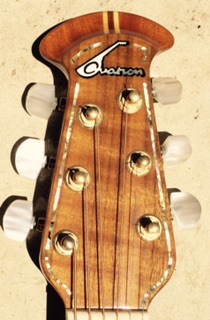|
|
Joined:
February 2004
Posts: 70
Location: kansas | I'm whittling out a saddle for my Ovation with a 1/4" wide Tusq saddle blank.
The original saddle doesn't provide compensation for the B-string; other than the 2 - E string positions (if the saddle slot was made at an angle, all of the saddle posts could all be in-line?).
Should I consider off-setting the B-string saddle position to provide improved intonation? |
|
| |
|

Joined:
January 2002
Posts: 14127
Location: 6 String Ranch | If you have room to do it move the B back and the G up. |
|
| |
|
Joined:
November 2004
Posts: 4413
| I thought this was going to be a class action thing. I thought we were all going to be rich. |
|
| |
|
Joined:
February 2004
Posts: 70
Location: kansas | here's a couple of sites that talk about saddle compensation:
http://www.lutherie.net/saddle_angle.html
at this site search on "fully compensated saddle"
http://www.dreamguitars.com/petros.htm
this picture shows ways to add compensation to a saddle design(I'm leaning towards doing 'A'):
http://www.guitarsaddles.com/images/Tech%20Breedlove%20saddles.JPG
not sure about needing to compensate for G, yet....
I remember setting the intonation on a strat by tuning a string with a quartz tuner and then fretting it at the 12th fret and adjusting the saddle according to the sharp/flat reading on the tuner.
Can't see doing this for acoustic fixed bridge, but maybe I'll try checking the intonation before and after the saddle modification...
Other factors like the string sizes & height setting above the neck may add to the need to compensate differently for each string position?
later... |
|
| |
|
Joined:
February 2004
Posts: 70
Location: kansas | this is a saddle from an all aluminum guitar
( http://www.flickr.com/photos/73172138@N00/ ) :
http://www.flickr.com/photo_zoom.gne?id=140188349&size=o
It looks like the B-string is compensated the most. |
|
| |
|
Joined:
October 2006
Posts: 51
Location: Arizona | Thanks for the links.
Those all make sense to me as far as what's going on with the strings, etc. My T-5, which has had excellent intonation since new, had the first three strings following the same trend as identified typically for the first two, i.e., the first three strings follow a steep slope, which then resets for the next three. This is apparently because T5s come with electric (Nanoweb) strings so the first three are unwound rather than the first two.
But then I looked at my Elite-T...huh? The middle four strings follow the same slope, and high E is compensated forward (makes sense relative to the B), and the low-E is compensated back. Elite's sound great, but I don't grok the compensation configuration on the saddle. |
|
| |
 B-string Compensation
B-string Compensation


